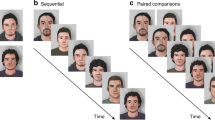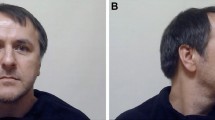Abstract
The present experiment investigates the effect of weapons on eyewitness recall and recognition using a new experimental paradigm in which a syringe serves as weapon simulation. Contrary to previous weapon manipulations using slides or films of armed targets, the syringe paradigm is personally threatening to the subject. In a 2×2 design, 86 nonpsychology students were approached by an experimenter who was either holding a syringe or a pen and either did or did not threaten to administer an injection. Exposure to the syringe greatly decreased lineup recognition,p<.05, while enhancing the accuracy of recall for hand cues,p<.05. Contrary to predictions derived from the cue utilization hypothesis, threat of injection was not found to interact with the syringe manipulation. Investigation of individual differences indicated greater accuracy of recall for facial details the lower the subjects' fear of injections and the greater their cognitive abilities (closure and memory).
Similar content being viewed by others
References
Amthauer, R. (1973).I-S-T (70). Göttingen: Hogrefe.
Cutler, B. L., Penrod, S. D., & Martens, T. K. (1987). The reliability of eyewitness identification: The role of system and estimator variables.Law and Human Behavior, 11, 233–258.
Cutler, B. L., Penrod, S. D., O'Rourke, T. E., & Martens, T. K. (1986). Unconfounding the effects of contextual cues on eyewitness identification accuracy.Social Behavior, 2, 113–134.
Easterbrook, J. A. (1959). The effect of emotion on cue utilization and the organization of behavior.Psychological Review, 66, 183–201.
Horn, W. (1962).Leistungsprüfsystem (LPS). Göttingen: Hogrefe.
Jessnitzer, K. (1980).Der gerichtliche Sachverstandige. Koln: Heymanns.
Johnson, C., & Scott, B. (1976, September). Eyewitness testimony and suspect identification as a function of arousal, sex of witness, and scheduling of interrogation. Paper presented at the American Psychological Association meeting.
Loftus, E. F. (1979).Eyewitness testimony. Cambridge, Massachusetts: Harvard University Press.
Loftus, E. F., Loftus, G. R., & Messo, J. (1987). Some facts about “weapon focus.”Law and Human Behavior, 11, 55–62.
Roxin, C. (1977).Strafverfahrensrecht. Munchen: Beck.
Thurstone, L. L. (1950).Multiple factor analysis. Chicago: University of Chicago Press.
Tooley, V., Brigham, J. C., Maass, A. & Bothwell, R. K. (1987). Facial recognition: Weapon effect and attentional focus.Journal of Applied Social Psychology 17, 845–459.
Wells, G. L. (1985). Verbal descriptions of faces from memory: Are they diagnostic of identification accuracy?Journal of Applied Psychology, 70, 619–626.
Wells, G. L., & Lindsay, R. C. L. (1980). On estimating the diagnosticity of eyewitness nonidentifications.Psychological Bulletin, 88, 776–784.
Wells, G. L., & Murray, D. M. (1983). What can psychology say about the Neil v. Biggers criteria for judging eyewitness accuracy?Journal of Applied Psychology, 68, 347–362.
Wells, G. L., & Turtle, J. W. (1986). Eyewitness Identification: The importance of lineup models.Psychological Bulletin, 99, 320–329.
Yarmey, A. D., & Jones, H. P. T. (1983). Is eyewitness identification a matter of common sense? In S. Lloyd-Bostock, & B. R. Clifford (Eds.),Evaluating witness research: Recent psychological research and new perspectives (pp. 13–40). New York: Wiley.
Yerkes, R. M., & Dodson, J. D. (1908). The relation of strength of stimulus to rapidity of habit formation.Journal of Comparative Neurology and Psychology, 18, 459–482.
Author information
Authors and Affiliations
Additional information
This research project was supported in part by a grant of the Deutsche Forschungsgemeinschaft to Günther Köhnken. The authors would like to thank Gabriele Knaab, Gabriele Dieckmann, and Ursula Dannenberg for ably conducting the research.
About this article
Cite this article
Maass, A., Köhnken, G. Eyewitness identification: Simulating the “Weapon effect”. Law Hum Behav 13, 397–408 (1989). https://doi.org/10.1007/BF01056411
Issue Date:
DOI: https://doi.org/10.1007/BF01056411




